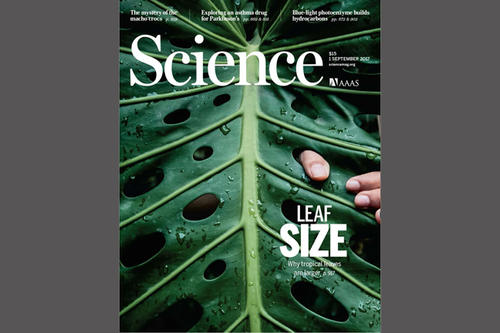
A global team of researchers, including Peter Reich from the University of Minnesota’s College of Food, Agricultural and Natural Resource Sciences, have cracked the mystery of leaf size. Their research was published today as a cover story in Science.
Why is a banana leaf a million times bigger than a spruce needle? Why are leaves generally much larger in tropical jungles than in temperate forests and deserts? The textbooks say it’s a balance between water availability and overheating.
But it’s not that simple.
The research, led by Professor Ian Wright from Macquarie University in Australia reveals that in much of the world the key limiting factor for leaf size is night temperature and the risk of frost damage to leaves.
Wright, Reich and colleagues from Australia, Canada, Argentina, Spain, China and more analysed leaves from over 7,600 species, then teamed the data with new theory to create a series of equations that can predict the maximum viable leaf size anywhere in the world based on the risk of daytime overheating and night-time freezing.
The researchers will use these findings to create more accurate global vegetation models. These will be used by governments to predict how vegetation will change locally and globally under climate change, and to plan for adaptation.
The iconic paintings of Henri Rousseau illustrate that when we think of steamy tropics we expect large leaves. But for scientists it’s been a century-old conundrum: why does leaf size vary with latitude – from very small near the poles to massive leaves in the tropics?
“It was long thought that overheating was the primary limit to leaf size. But the data didn’t fit,” said Reich. “For example although much of the tropics is wet, leaves can still get very hot in tropical heat, yet many tropical leaves are big. On the other hand, leaves in cooler parts of the world are unlikely to overheat, but many of them are small. Our team took a different approach – we asked whether cold as well as heat could be problems for large leaves.”
The researchers used so-called “big data”; in this case measurements made on tens of thousands of leaves. By sampling across all continents, climate zones and plant types they found simple ‘rules’ that operate across the world’s plant species, rules that were not apparent from previous analyses. The research confirmed that in very hot and very dry regions the risk of daytime overheating controls maximum leaf size. But in the warm wet tropics, there are no temperature-related limits to leaf size, provided there is enough water available for transpirational cooling. A surprising result noted by researchers was that over much of the world the maximum size of leaves is set not by the risk of overheating, but rather by the risk of frost at night.
Lead author Ian Wright added , “Larger leaves have thicker, insulating ’boundary layers‘ of still air that slows their ability to draw heat from surrounding leaves and branches – heat that is needed to compensate for longwave energy lost to the cold, night-time sky.”
“It should be no surprise then that these mechanisms influence plants closer to home too,” Reich said. “Minnesota’s deciduous plant species, like maples and oaks, must cope with the risk of frost, in spring and fall, and those that stay green all winter, like our pines and spruces, must deal with much deeper cold. As a result, maple and oak leaves are smaller than banana leaves, but much bigger than needles of pines and spruces. We can throw a parka and hat on to stay comfortable at 30 below, but since leaves can’t, they have to adapt any way they can. “
About University of Minnesota College of Food, Agricultural and Natural Resource Sciences
The University of Minnesota College of Food, Agricultural and Natural Resource Sciences (CFANS) brings science-driven innovators together to discover hands-on solutions to global challenges. With 10 research and outreach centers across Minnesota, the Minnesota Landscape Arboretum, and the Bell Museum of Natural History, CFANS offer unparalleled experiential learning opportunities for students and the community. CFANS students enter career fields with some of the best job outlooks in the country, including 13 undergraduate majors and more than 25 minors ranging from agricultural education and marketing communications to conservation biology and forest and natural resource management, health and nutrition, to the future of food and agriculture management with a focus on business and technology.
Read the full research here: https://dx.doi.org/10.1126/science.aal4760
- Categories:
- Science and Technology





